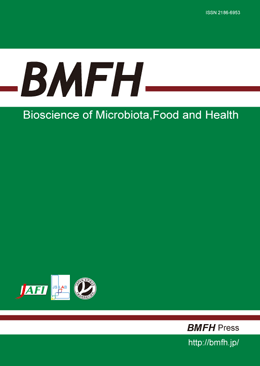Volume 43, Issue 1
Displaying 1-10 of 10 articles from this issue
- |<
- <
- 1
- >
- >|
Letter to the editor
-
Article type: Letter to the editor
2024 Volume 43 Issue 1 Pages 1-3
Published: 2024
Released on J-STAGE: January 01, 2024
Advance online publication: September 06, 2023Download PDF (582K)
Review
-
Article type: Review
2024 Volume 43 Issue 1 Pages 4-12
Published: 2024
Released on J-STAGE: January 01, 2024
Advance online publication: June 29, 2023Download PDF (859K)
Full Paper
-
Article type: Full Paper
2024 Volume 43 Issue 1 Pages 13-22
Published: 2024
Released on J-STAGE: January 01, 2024
Advance online publication: July 31, 2023Download PDF (1155K) -
Article type: Full Paper
2024 Volume 43 Issue 1 Pages 23-28
Published: 2024
Released on J-STAGE: January 01, 2024
Advance online publication: September 07, 2023Download PDF (1233K) -
Article type: Full Paper
2024 Volume 43 Issue 1 Pages 29-42
Published: 2024
Released on J-STAGE: January 01, 2024
Advance online publication: September 04, 2023Download PDF (8035K) -
Article type: Full Paper
2024 Volume 43 Issue 1 Pages 43-54
Published: 2024
Released on J-STAGE: January 01, 2024
Advance online publication: September 12, 2023Download PDF (5263K) -
Article type: Full Paper
2024 Volume 43 Issue 1 Pages 55-63
Published: 2024
Released on J-STAGE: January 01, 2024
Advance online publication: September 18, 2023Download PDF (3087K) -
Article type: Full Paper
2024 Volume 43 Issue 1 Pages 64-72
Published: 2024
Released on J-STAGE: January 01, 2024
Advance online publication: October 18, 2023Download PDF (3023K) -
Article type: Full Paper
2024 Volume 43 Issue 1 Pages 73-80
Published: 2024
Released on J-STAGE: January 01, 2024
Advance online publication: October 30, 2023Download PDF (3748K) -
Article type: Full Paper
2024 Volume 43 Issue 1 Pages 81-91
Published: 2024
Released on J-STAGE: January 01, 2024
Advance online publication: November 03, 2023Download PDF (749K)
- |<
- <
- 1
- >
- >|
